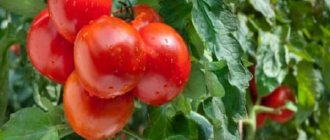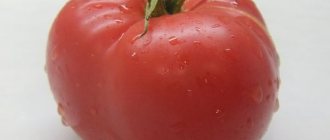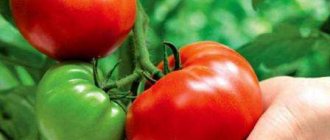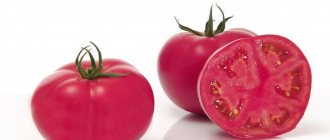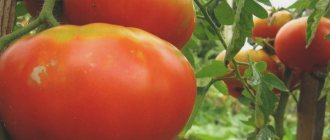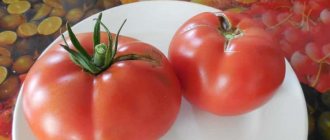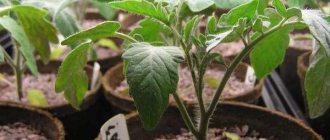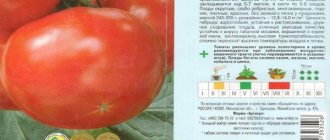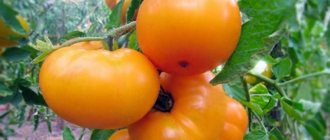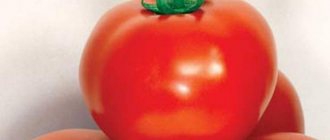» Vegetable growing » Tomatoes » Growing tomato Energy
0
2437
Article rating
Domestic breeders developed the Energo tomato, which was included in the official register of hybrid varieties in 1996. During its existence, it has not lost its popularity. This is one of the few varieties suitable for growing in different climatic zones.
- Advantages and disadvantages
- Features of cultivation
- Deadlines
- Soil and seed preparation
- Sowing stages
- Seedling care
- Transplanting seedlings into the ground
- Care
- Watering and loosening
- Bush formation and pinching
- Top dressing
- Reviews from gardeners
Growing tomato Energy
Features of the hybrid
An early-ripening and high-yielding hybrid of semi-determinate type. Tomato "Energo" is resistant to temperature changes, so it is suitable for growing both in greenhouses and in open ground. Fruit ripening occurs already on the 110th day after germination.
Advantages of the variety
- Intensive formation of bushes and fruits.
- The brushes are laid at a shorter distance - 12-18 cm, after one or two sheets. This allows the plant to produce more clusters.
- Good fruit set.
- Plant resistance to viruses and diseases.
- Increased plant plasticity.
- The only hybrid that is recommended for all climatic zones of the Russian Federation.
Fetal characteristics
- The outer shape is round.
- Rich red color.
- The skin is dense and smooth.
- Inside, the fruit is divided into four or five segments.
- Weighs, on average, 100-150 grams.
- Excellent taste.
At the beginning of ripening, a dark spot is observed on the stalk, which disappears when fully ripe, and the fruit acquires a uniform color. The size of the tomatoes is ideal for pickling, and due to their taste, the fruits can be eaten both in their natural form and in processed form.
Review of tomato Energo
from small tomatoes (salt) for 5: intuition, vitador, kirzhach, energy
kis77
https://www.nn.ru/community/dom/dacha/kakie_sorta_budem_sazhat_v_sleduyushchem_godu.html
From the Kirov selection of cucumbers, Cheboksary impressed me with both taste and yield) Volzhsky, Vyatsky - good, but not great) As for tomatoes, I liked the Khlynovsky variety, energetic and family-friendly.
Khimichka
https://www.u-mama.ru/forum/family/dacha/278759/4.html
My most reliable one is Khlynovsky. Vyatich and Energo performed well.
Sveta
https://www.e1.ru/talk/forum/read.php?f=122&i=170321&t=170321&
I planted Energo F1, I like these tomatoes. Plant height is 1–1.5 m, medium-sized fruits.
Larisa Stepanova
https://ok.ru/urozhaynay/topic/66412582835482
Energy can be grown in open ground with minimal care, but then the harvest will be normal. To get the number of fruits per square meter declared by the manufacturer, plant the hybrid in a greenhouse, feed it intensively and water it.
Sowing and cultivation
- Tomatoes of this variety should be sown in the second half of March in prepared, moist soil. The sowing depth should not exceed 2 cm.
- The optimal temperature for seed germination is 20-22 degrees.
- During the phase of the appearance of the first true leaves, seedlings should be picked.
- After picking, it is necessary to fertilize; for this it is recommended to use sodium humate.
- To prevent plants from experiencing stress after planting, they need hardening. After the shoots have grown stronger, they should be taken out into fresh air or a window should be opened, avoiding drafts.
See also
Characteristics and description of the Lakomka tomato varietyRead
Features of cultivation and storage
The beds are prepared for planting in advance. For 2-3 weeks, add 1 bucket of compost, 20 g superphosphate, 10 g potassium sulfate per 1 m2. The earth is being dug up.
4-5 bushes are planted per 1 m2. They try to make holes 20 cm deep. The roots are straightened and the earth is compacted on top.
What subtleties of care are observed:
- Driving in 2-3 barrels.
- Balanced feeding at least 2 times a month.
- For prevention, irrigation with copper preparations.
Reddened tomatoes can be stored for up to 1 month without loss of commercial quality. The rooms are chosen to be dark and cool.
Specifics of care after disembarkation
- You can plant seedlings in a greenhouse in mid-April, under film in early May, and in open ground no earlier than 50 days from germination. If the seedlings are kept too long and not planted before flowering, it is better to remove the brush with flowers, this will help avoid premature termination. The fruits on such a cluster, even if they set, will be small and underdeveloped.
- Scheme for planting tomatoes “Energo” 40 x 70 cm or two and a half bushes per 1 sq. m.
- Before planting, it is advisable to spill the soil with a solution of potassium humate: 25 ml of potassium humate 3% per 10 liters of water.
- Immediately after planting the seedlings, it is necessary to prevent the sprouts from late blight. Feedback from experienced vegetable growers convinces of the need to alternate treatment agents, since the fungus is tenacious and quickly adapts if the same preventative drug is used every year.
- The plant needs rare but abundant watering. The soil is moistened carefully at the root, avoiding erosion around the bush.
- And of course, you need to regularly loosen, weed and hill.
- Tomato "Energo" is a medium-sized type. Although the growth of the plant is limited, the height of the bush can reach from one and a half to two meters, so it requires additional support; the bush should be tied under the first brush.
- It is recommended to fertilize the soil 4-6 times per season with complex mineral mixtures. Tomatoes love feeding and “Energo” is no exception. In addition, semi-determinants are tomatoes of generative growth; they tend to sacrifice the development of the bush and roots in favor of the formation of fruits. To prevent this from happening, they must be fed diligently. The first feeding of tomatoes should be done after the first ovaries reach the size of a walnut.
- Forming a bush with two or three stems and mercilessly removing stepsons will help achieve an increased yield. But in case of early termination of the plant, it is worth leaving one, so to speak, backup stepson. This technique will make it possible to get a larger harvest of tomatoes.
See also
Description of the tomato variety Cerrinano and its cultivation methodsRead
As soon as the tomatoes turn red, they should be removed from the bush. Untimely harvesting inhibits the growth of the plant and the ripening of the remaining fruits.
How are tomatoes grown?
Let's look at how tomatoes are grown. It takes at least 2 months from seed germination to mature crop growth, so seedlings should be planted in late February-early March.
To protect plants at the seedling stage from infection, it is recommended to disinfect the containers. Disinfection is usually carried out with potassium permanganate; if it is not available, then you can use hydrogen peroxide.
See also
Description of Iceberg tomato, characteristics and rules for growing the variety, reviews
Read
When the first true leaves appear, it is necessary to plant the plants in separate containers. If the bush has managed to grow, but the time for planting has not yet come, then it can be tied to a support.
At the end of April and beginning of May, the tomato is planted in the greenhouse. The bushes must be planted at a distance of 1 m from each other, otherwise they will grow weak and will be difficult to tie up. When planting in the ground, it is necessary to cut off the first lower leaves on the bush and immediately tie up the branches. Tomatoes are planted in a previously prepared hole, well watered - this way the tomatoes will take root better.
The variety is quite unpretentious. If the climate allows, then the tomato can be grown outside the greenhouse in open ground, but the height of the plant should be taken into account (it reaches 2 m), accordingly, it is necessary to ensure the possibility of tying the bush. In July-August, during the fruiting period, dew begins to fall, which is destructive to the fruits (they turn black), so the bush will need to be protected.
Fertilizing is very important for all types of plants. Tomatoes need nitrogenous fertilizers. You can sprinkle special phosphorus and calcium fertilizers or use natural mixtures: egg shells, which contain calcium, fish bones (phosphorus). In this case, fertilizing with complex fertilizers should be done during the first ovaries and when the fruits are filling.
Abundant watering is necessary if the summer is dry and hot.
To get a good harvest, you need to periodically form a bush: trim the stepsons and tops. The size of the future harvest directly depends on this. According to the classic cultivation, the key 1-2 stems from the branch are left, and the rest are removed.
Tomatoes can be removed from the branch when they have just begun to turn red. The fruits ripen on their own, in addition, you will preserve the strength of the bush and increase the shelf life of harvested tomatoes. It should be taken into account that before pickling it is necessary to wait until the fruits are fully ripened.
See also
Description of the Don Juan tomato, its characteristics and cultivation features
Read
The tomato variety Energo f1 has a very low probability of bush death combined with high yield. This variety is an excellent option for growing tomatoes for both beginners and experienced gardeners for commercial purposes. Reviews from vegetable growers about this variety are positive.
Tomato Energo F1: description and characteristics of the variety, cultivation features, reviews, photos
Energo is not as popular as the varieties and hybrids of the large Moscow and Aelita varieties. The tomato was created by a Kirov company with the modest name “Agrosemtoms”. Meanwhile, Energo is not inferior in yield to Dutch hybrids, and in taste to Russian varieties.
Description of tomato Energy
Hybrid Energo is officially registered as a selection achievement and has been listed in the State Plant Register since 1996. The tomato is approved for cultivation in all light zones of Russia and is considered one of the best in terms of adaptation to different climatic conditions. It tolerates temperature changes well and is resistant to tobacco mosaic, cladosporiosis and fusarium.
: Energo bushes in the greenhouse are tied and filled with fruits
Energo received this name for the intensive growth of the stem and fruits. Its bush is semi-determinate: in greenhouses it grows up to 1.5–2 m, in open ground it reaches the height of 1 m. The ripening period of a tomato is 110–115 days. The fruits are round, slightly flattened at the poles, and red when fully ripe. The weight of one tomato is 120–140 g.
Energo fruits are bright red, flat-round, medium in size
The pulp and skin are dense, with 4–5 seed chambers inside. The taste of tomatoes is excellent both fresh and canned. Gardeners grow it mainly for pickling.
Unfortunately, there are no yield indicators either in the description from the State Register or on the manufacturer’s website. But on the bags of seeds from the author - "Agrosemtoms" there are the following numbers: 25–27 kg/m², and with good care - up to 32 kg/m².
The author of tomato Energo claims quite high yields
About the benefits of Energo, comparison with other tomatoes
The peculiarity of Energo is its intermediate position between determinate and indeterminate tomatoes.
Comparative table of characteristics of tomatoes with different types of bush
Hence the high yield of Energo, especially in greenhouses. The bush grows tall, like an indeterminate tomato, and is literally all hung with fruit clusters, like a determinate one. The garden bed area is used efficiently.
It makes no sense to compare energy with indeterminate or determinate varieties and hybrids. It is more productive than the Dutch Solerosso, the German Marusya and even the Chelyabinsk Maryina Roshcha. The listed tomatoes are suitable for pickling and salads, are zoned for all regions of the Russian Federation, and are resistant to diseases, like Energo. This hybrid can only be matched by the same semi-determinate tomatoes.
Table: comparison of semi-determinate red tomatoes
In the State Register, such varieties are most often described as determinate, medium- and tall-growing.
Review of tomato Energo
Energy can be grown in open ground with minimal care, but then the harvest will be normal. To get the number of fruits per square meter declared by the manufacturer, plant the hybrid in a greenhouse, feed it intensively and water it.
Source: https://diz-cafe.com/sad-ogorod/tomat-energo-harakteristika-i-opisanie-sorta.html
Tomato Energo: characteristics and description of the variety, growing features
The early-ripening, red-fruited, high-yielding tomato “Energo F1” has been widespread in our homeland for more than 20 years. It is loved by vegetable growers for the opportunity to obtain early produce in any conditions, including in spring film or winter greenhouses.
Plant characteristics
Tomato "Energo F1" of a semi-determinant growth type is represented by plants of average height of about 1.5-2 meters, depending on growing conditions. The bushes are semi-spreading, moderately branched and slightly leafy.
The foliage is slightly corrugated, glossy, rich dark green in color. Medium-sized flowers are collected in simple and compact inflorescences.
The first cluster with flowers on the main stem is placed above 8-9 leaves, on secondary stems above 3-5, and all subsequent ones - after 1-2 leaves.
Description and use of fruits
The fruits have a regular round shape, weighing on average 100-150 g. The color at the beginning of ripening is green with a dark spot at the stalk. When fully ripe, they acquire a uniform, rich red color, and the dark green spot completely disappears. The tomatoes are dense, five-chambered, with smooth, glossy and elastic skin.
They have a classic tomato aroma and pleasant taste with a harmonious combination of sugars and acids. The transportability and keeping quality of the fruit are excellent. Thanks to the combination of these qualities, the fruits are universal in purpose. They are eaten fresh, their size and density are ideal for pickling, good for various dishes and winter preparations.
Excellent presentation contributes to stable demand in the consumer market.
Productivity
The yield of the hybrid is very high under any growing conditions. In winter, in greenhouses with 1 m2 it produces from 12 to 22 kg of fruit, in film shelters from 7 to 10 kg per 1 m2. Tomatoes should be removed from the bush as they ripen. Late harvesting negatively affects the growth of the plant and the ripening of other tomatoes.
Interesting! Semi-determinate tomatoes occupy the golden mean between determinate (short-growing) and indeterminate (tall) and combine the best qualities of both.
The advantages of semi-determinate tomatoes are early ripening and tall plants.
They produce their harvest much earlier than indeterminate tomatoes and the yield indicators are much higher than those of determinate tomatoes.
When to sow?
Tomato seeds “Energo F1” must be sown in such a way that by the time of transplantation to a permanent place, the age of the seedlings is 50-55 days. Overgrown seedlings do not adapt well and grow slowly, which entails a decrease in yield.
How to prepare the soil for seedlings?
Despite the fact that this hybrid is completely unpretentious, it is better not to neglect pre-planting soil preparation.
It is preferable to purchase soil at a specialized retail outlet. The ideal option would be soil for tomatoes and peppers or universal soil for vegetables. Such soil mixtures meet all the requirements necessary for the normal growth and development of tomatoes. They contain all the necessary substances and have neutral acidity.
Purchasing ready-made soil does not provide a 100% guarantee of the absence of pathogenic microbes. Therefore, the soil is disinfected using any of the following methods:
- freezing (in the freezer or outside at sub-zero temperatures);
- calcination or steaming (in the oven, microwave or water bath);
- treatment with a solution of copper sulfate (one teaspoon per five liters of water);
- etching with a solution of potassium permanganate (1 g per 1 liter of water);
- treatment with any commercially available combination preparation with a fungicidal effect.
It should be remembered that the first two methods make the soil sterile, that is, during the processing process, not only pathogenic microbes are killed, but also beneficial ones. Therefore, after disinfection, it is necessary to restore the normal microflora of the soil using special microbiological preparations.
Do the seeds need to be treated?
Hybrid seeds from large agricultural companies have already passed the necessary stages of processing and do not require disinfection. They are fully prepared for sowing. If desired, the seeds are soaked in warm water for 12 hours, this will ensure uniform germination of the seedlings.
How to care for seedlings?
For normal growth, tomato seedlings require the following conditions:
- Sun or artificial light at least 11 hours a day.
- Air temperature: from sowing to germination – 20-25 °C around the clock;
- within a week after emergence – 12-15 °C during the day and 6-10 °C at night;
- subsequently – 20-23°C during the day and 12-15°C at night.
You may be interested in:
If the seedlings do not show signs of starvation, then there is no need to feed the seedlings. Small sprouts have enough nutrients contained in the soil. Grown plants require more nutrition, and they will receive it after picking, as they will again find themselves in well-filled fertile soil.
How to plant in the ground correctly?
If the seedlings already have one or more flowering racemes at the time of replanting, they must be removed, otherwise this will lead to the plant growing too early. This can be done without regret, because the fruits on these shoots will either not set at all, or will be small and unsightly.
Before planting seedlings, the soil is fertilized with potassium humate, diluted in accordance with the instructions, and superphosphate can also be added to each bush (3 grams per plant). This strengthens the root system and stimulates the growth of tomatoes.
Planting pattern: minimum distance between bushes is 40 cm, between rows 70 cm. More frequent planting will lead to a decrease in yield and an increase in the risk of disease.
How to form and tie bushes?
To obtain maximum yields, tomato bushes are formed into two or three stems. The remaining stepsons are removed during the growing season.
On the side stems, it is more advisable to wait until 3-4 clusters form and then pinch them off.
Subsequently, the growth of the plant is monitored and, in order to prolong fruiting, new stems are formed during early termination, leaving several shoots untouched during pinching.
The growth of this hybrid is limited, but the plants grow quite tall and require support and tying.
Important! When removing shoots, leave stumps 2-3 cm long. If this is not done, the stepson will grow again. It is better to carry out the procedure in dry and sunny weather, so the wounds will dry out faster.
How to feed?
The semi-determinate tomato "Energo F1" has a degenerative growth pattern. In plants of this type, at the genetic level, it is determined to form ovaries, and the growth and development of the bush itself suffers.
To avoid this, plants of this type should be fertilized at least 5 times per season. The first fertilizing is carried out with phosphorus fertilizers during the color of the first brush. Nitrogen and potassium substances are fed during the period of growth of the first fruits.
The next application occurs at the time of formation of 5-6 brushes and then regularly every 10-15 days.
Disease resistance
The hybrid is resistant to the following diseases:
- tobacco mosaic virus;
- cladosporiosis;
- gray rot;
- fusarium wilt;
- root-knot nematode;
- macrosporiosis.
To protect tomatoes from late blight, it is necessary to carry out preventive treatments throughout the season, starting immediately after transplanting the seedlings to a permanent place. To prevent the fungus from adapting, the drugs must be alternated.
Advantages and disadvantages
Tomato has a number of advantages:
- unique plasticity;
- consistently high productivity;
- early ripening;
- excellent taste of the fruit;
- good transportability;
- attractive presentation;
- versatility of use;
- resistant to most diseases.
The disadvantages, or rather the difficulties that you will have to face when growing this hybrid, include:
- the need to form a bush;
- support and tying are required;
- demanding of fertilizing.
Tomato "Energo F1" is a good option for amateur gardeners to obtain a harvest for their own needs, and for peasants and farms for commercial cultivation throughout Russia.
Where can I buy?
Tomato seeds “Energy” can be bought in the large online seed store “Gardens of Russia”. Place your order in just a few clicks.
Reviews
Olga, 56 years old I have been growing tomatoes for a very long time, every year I plant 35-40 different varieties and hybrids.
I respect Kirov seeds, every year I plant anything from the Kirov region, their tomatoes are well-hardened and resistant to all sorts of diseases.
“Energo” grew in my greenhouse, formed into one stem, the bush formed 10 clusters of about 6 tomatoes each. I liked it - early, productive, fits well and is not afraid of transportation.
For salads, of course, it is a bit sour, but it is not declared as salad. And for pickling, that’s what you need. I recommend to all.
Source: https://sveklon.ru/tomat-jenergo
